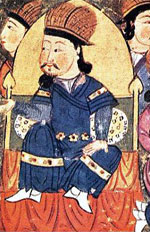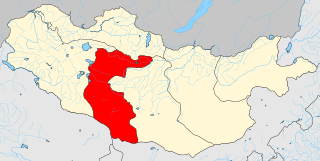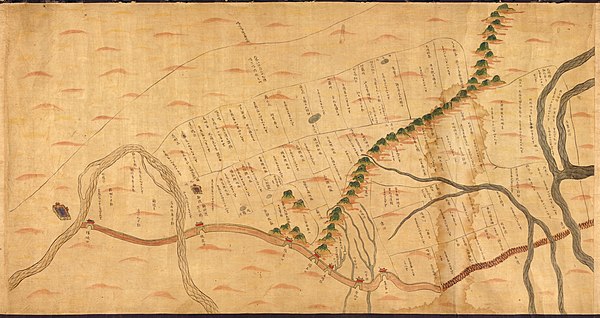
The Mongols are an East Asian ethnic group native to Mongolia, China, as well as Buryatia and Kalmykia of Russia. The Mongols are the principal member of the large family of Mongolic peoples. The Oirats in Western Mongolia as well as the Buryats and Kalmyks of Russia are classified either as distinct ethno-linguistic groups or subgroups of Mongols.
Dayan Khan, born Batumöngke, (1472–1517) was a khagan of the Northern Yuan dynasty, reigning from 1480 to 1517. During his rule, he reunited the Mongols under Chinggisid supremacy. His reigning title, "Dayan", means "the whole" or "Long lasting" in Mongolian language as he was the longest reigning khaan of the unified Mongols.
Articles related to Mongolia include:

Altan Khan of the Tümed, whose given name was Anda, was the leader of the Tümed Mongols and de facto ruler of the Right Wing, or western tribes, of the Mongols. He was the grandson of Dayan Khan (1464–1543), a descendant of Kublai Khan (1215–1294), who had managed to unite a tribal league between the Khalkha Mongols in the north and the Chahars (Tsakhars) to the south. His name means "Golden Khan" in the Mongolian language.

The Khalkha or Kalka have been the largest subgroup of Mongol people in modern Mongolia since the 15th century. The Khalkha, together with Chahars, Ordos and Tumed, were directly ruled by Borjigin khans until the 20th century; unlike the Oirats, who were ruled by Dzungar nobles or the Khorchins, who were ruled by Qasar's descendants.
A banner is an administrative division of the Inner Mongolia Autonomous Region in China, equivalent to a county-level administrative division.

Tannu Uriankhai was a historical region of the Mongol Empire, its principal successor, the Yuan dynasty, and later the Qing dynasty. The territory of Tannu Uriankhai largely corresponds to the modern-day Tuva Republic of the Russian Federation, neighboring areas in Russia, and a small part of the modern state of Mongolia.
Chingünjav (Mongolian: Чингүнжав, Chinese: 青袞雜卜; also known as Admiral Chingün was the Khalkha prince ruler of the Khotogoids and one of the two major leaders of the 1756-57 rebellion in Outer Mongolia. Although his rebellion failed, he is nowadays often hailed as a fighter for Outer Mongolia's independence from the Manchu-led Qing dynasty of China.

Mongolia under Qing rule was the rule of the Manchu-led Qing dynasty of China over the Mongolian Plateau, including the four Outer Mongolian aimags and the six Inner Mongolian aimags from the 17th century to the end of the dynasty. The term "Mongolia" is used here in the broader historical sense, and includes an area much larger than the modern-day state of Mongolia. By the early 1630s Ligdan Khan saw much of his power weakened due to the disunity of the Mongol tribes. He was subsequently defeated by the Later Jin dynasty and died soon afterwards. His son Ejei handed the Yuan imperial seal over to Hong Taiji in 1635, thus ending the rule of the Northern Yuan dynasty in Inner Mongolia. However, the Khalkha Mongols in Outer Mongolia continued to rule until they were overrun by the Dzungar Khanate in 1690, and they submitted to the Qing dynasty in 1691.

Khotogoid is a subgroup of Mongol people in northwestern Mongolia. The Khotogoid people live roughly between Uvs Lake to the west and the Delgermörön river to the east. The Khotogoids belong to northwestern Khalkha and were one of the major groups that make up Khalkha.

The Mongolian nobility arose between the 10th and 12th centuries, became prominent in the 13th century, and essentially governed Mongolia until the early 20th century.

The Kharchin, or Kharachin, is a subgroup of the Mongols residing mainly in North-western Liaoning and Chifeng, Inner Mongolia. There are Khalkha-Kharchin Mongols in Dorno-Gobi Province and in Ulaanbaatar, Mongolia.

The Northern Yuan was a dynastic regime ruled by the Mongol Borjigin clan based in the Mongolian Plateau. It existed as a rump state after the collapse of the Yuan dynasty in 1368 and lasted until its conquest by the Jurchen-led Later Jin dynasty in 1635. The Northern Yuan dynasty began with the retreat of the Yuan imperial court led by Toghon Temür to the Mongolian steppe. This period featured factional struggles and the often only nominal role of the Great Khan.
Various nomadic empires, including the Xiongnu, the Xianbei state, the Rouran Khaganate (330–555), the First (552–603) and Second Turkic Khaganates (682–744) and others, ruled the area of present-day Mongolia. The Khitan people, who used a para-Mongolic language, founded an empire known as the Liao dynasty (916–1125), and ruled Mongolia and portions of North China, northern Korea, and the present-day Russian Far East.
An aimag, originally a Mongolian word meaning 'tribe', is an administrative subdivision in Mongolia, Russia, and in the Inner Mongolia region of China.
Bat-Ochiryn Togtokhtör known as To Wang or as Hetsuu Wang Togtokhtör was a Mongolian nobleman and politician.

Tüsheet Khan refers to the territory as well as the Chingizid dynastic rulers of the Tüsheet Khanate, one of four Khalka khanates that emerged from remnants of the Mongol Empire after the death of Dayan Khan's son Gersenji in 1549 and which continued until 1930.

Sechen Khan, also spelled Setsen Khan, refers to the territory as well as the Chingizid dynastic rulers of the Secen Khanate. It was one of four Khalka khanates that emerged from remnants of the Mongol Empire after the death of Dayan Khan's son Gersenji Khongtaiji in 1549.

Zasagt Khan, also spelled Zasagtu Khan or Jasaghtu Khan, refers to the territory as well as the Chingizid dynastic rulers of the Zasagt Khanate. It was one of four Khalka khanates that emerged from remnants of the Mongol Empire after the death of Dayan Khan's son Gersenji Khongtaiji in 1549.

Sain Noyon Khan, known as Sain Noyon before 1911, refers to the territory as well as the Chingizid dynastic rulers of the Sain Noyon Khanate.












